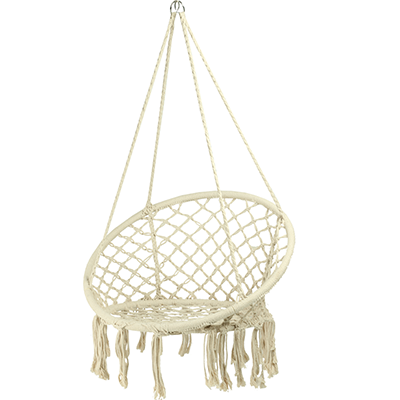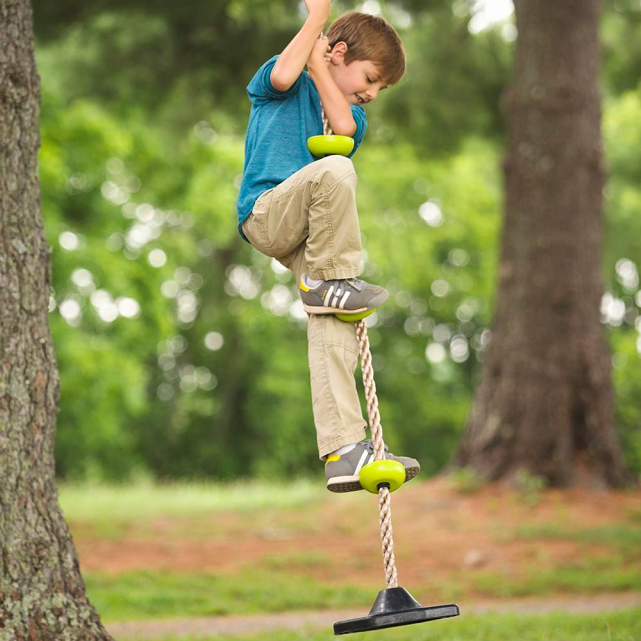Rope swings have been a popular outdoor activity for generations, and for good reason. They are an inexpensive, fun, and relatively simple way to enjoy the outdoors. Whether you are a child or an adult, there is something about the thrill of swinging through the air that just never gets old. However, if you are considering installing an outdoor rope swing, there are a few things you should keep in mind. Here’s what you need to know:
- Choose the Right Location: The first thing you need to consider is where you will install the rope swing. Make sure that the location you choose has enough space for the swing to move freely and that there are no obstacles in the way. It’s also important to ensure that the tree branch or other support you choose is strong enough to support the weight of the swing and the person using it.
- Select the Right Rope: The rope you choose for your swing is also important. You want a rope that is strong, durable, and able to withstand the elements. Nylon ropes are a popular choice because they are strong and resistant to abrasion and UV damage.
- Use Proper Hardware: It’s important to use the proper hardware to attach the rope to the tree branch or other support. Avoid using knots, as they can weaken the rope and cause it to fail over time. Instead, use a sturdy carabiner or other hardware specifically designed for use with rope swings.
- Safety First: Always prioritize safety when using a rope swing. Make sure the area around the swing is clear of obstacles, and make sure that the person using the swing understands how to use it safely. It’s also a good idea to supervise children when they are using the swing.
- Regular Inspections: Finally, make sure to inspect the rope swing regularly to ensure that it is still in good condition. Look for signs of wear and tear, such as frayed ropes or damaged hardware. Replace any damaged parts immediately to ensure the safety of anyone using the swing.
In conclusion, installing an outdoor rope swing can be a fun and rewarding project, but it’s important to do it safely. By choosing the right location, selecting the right rope, using proper hardware, prioritizing safety, and inspecting the swing regularly, you can enjoy this classic outdoor activity for years to come.

Is Rope Swinging Good?
Rope swinging is a popular outdoor activity that has been enjoyed by people of all ages for generations. It involves swinging back and forth on a rope that is attached to a tree or other sturdy structure, often over water or a steep drop. While many people find rope swinging to be a thrilling and fun activity, others may wonder whether it is actually good for them. In this post, we will explore the potential benefits and drawbacks of rope swinging.
Benefits of Rope Swinging:
- Physical Activity: Rope swinging is a great way to get exercise and burn calories. It requires the use of many muscles in the body, including the arms, core, and legs. Swinging on a rope can also improve coordination and balance.
- Stress Relief: Swinging on a rope can be a great way to relieve stress and improve mental health. The feeling of weightlessness and the rush of adrenaline can be exhilarating and help to clear the mind.
- Fun and Adventure: Rope swinging is a thrilling and adventurous activity that can be enjoyed by people of all ages. It can provide a sense of excitement and accomplishment, as well as create lasting memories.
Drawbacks of Rope Swinging:
- Injury Risk: Rope swinging can be dangerous if proper safety precautions are not taken. Falling from a high height can result in serious injury. It is important to use proper equipment and take necessary safety precautions, such as wearing a helmet and using a sturdy rope.
- Damage to Trees and Other Structures: Repeated use of a rope swing can damage the tree or other structure it is attached to. This can cause harm to the environment and may even result in property damage.
- Environmental Impact: Rope swinging can have a negative impact on the environment. If the swing is set up in a natural area, it can disrupt the ecosystem and damage plants and wildlife.
In conclusion, rope swinging can be a fun and exhilarating activity that provides a range of potential benefits, including physical activity, stress relief, and adventure. However, it is important to take necessary safety precautions and consider the potential drawbacks, such as injury risk and environmental impact. If you decide to try rope swinging, make sure to do so responsibly and safely, and always prioritize your own safety and the safety of others.

What is the Best Rope for Outdoor Tree Swing?
Outdoor tree swings are a popular activity for children and adults alike. They provide a fun and exciting way to enjoy the outdoors and can be a great addition to any backyard or park. However, choosing the right rope for your tree swing is crucial for safety and longevity. In this post, we will explore the different types of ropes available and which one is best for an outdoor tree swing.
- Nylon Rope: Nylon rope is a popular choice for outdoor tree swings due to its strength, durability, and resistance to abrasion and UV damage. It is also easy to tie and untie knots in, making it a convenient choice for those who want to install their own tree swing.
- Polypropylene Rope: Polypropylene rope is another popular option for tree swings. It is lightweight, strong, and resistant to mildew and moisture. However, it is less durable than nylon rope and may not last as long with frequent use.
- Manila Rope: Manila rope is a natural fiber rope that is made from hemp or jute. It is a strong and durable option that is resistant to stretching and abrasion. However, it is not as resistant to UV damage as nylon or polypropylene ropes, so it may not be the best choice for a tree swing that will be exposed to sunlight.
- Polyester Rope: Polyester rope is a strong and durable option that is resistant to UV damage, making it a good choice for outdoor tree swings. However, it is not as easy to tie knots in as nylon rope and may require special hardware or knots for installation.
In conclusion, nylon rope is generally considered to be the best option for an outdoor tree swing due to its strength, durability, and resistance to abrasion and UV damage. However, polypropylene, manila, and polyester ropes are also good choices depending on your specific needs and preferences. Whichever rope you choose, make sure to inspect it regularly and replace it if it shows signs of wear and tear to ensure the safety of anyone using the tree swing.
What is the Weight Limit of Rope Swing?
The weight limit of a rope swing depends on several factors, such as the strength and quality of the rope, the type of knot used, the anchor point, and the intended use of the swing.
As a general rule of thumb, a rope swing should be able to support at least 220 pounds (100 kg) of weight. However, it’s important to note that this is just a guideline and the weight limit may vary depending on the specific factors mentioned above.
To ensure the safety of the rope swing, it’s recommended to follow the manufacturer’s guidelines or consult with a professional rigger or engineer to determine the appropriate weight limit for your specific setup. It’s also important to regularly inspect the rope, anchor point, and knots for any signs of wear or damage, and to replace any worn or damaged components before using the swing.

Which is Better Nylon or Polypropylene Rope?
When it comes to selecting a rope, one of the most important decisions you will need to make is choosing the right material. Two popular materials for ropes are nylon and polypropylene. Both materials have their own advantages and disadvantages, and which one is better will depend on your specific needs and use case.
Nylon rope is a synthetic material that is known for its strength, durability, and elasticity. It is often used for heavy-duty applications, such as towing, lifting, and climbing. Nylon rope is also resistant to abrasion, UV rays, and chemicals, making it a good choice for outdoor use. Additionally, nylon rope is able to absorb shock, which can help reduce stress on the rope and any attached objects or people.
Polypropylene rope, on the other hand, is a lightweight and inexpensive synthetic material that is also resistant to UV rays and chemicals. It is often used for more general-purpose applications, such as securing cargo or tying down tarps. Polypropylene rope is also resistant to rot and mildew, making it a good choice for outdoor use.
So which one is better? It really depends on what you need the rope for. Nylon rope is a stronger and more durable material that can handle heavy loads and harsh conditions, while polypropylene rope is a lighter and more affordable option that is suitable for lighter duty applications.
If you are looking for a rope to use for heavy-duty applications, such as towing a vehicle or lifting heavy objects, then nylon rope would be the better choice. On the other hand, if you need a rope for more general-purpose use, such as securing a tarp or tying down a load in the back of a pickup truck, then polypropylene rope would be a more cost-effective option.
Ultimately, the choice between nylon and polypropylene rope will depend on your specific needs and use case. It’s important to consider factors such as load capacity, durability, and cost when making your decision, and to choose a rope that is suitable for the task at hand.
Read More:
ROPE SWING SAFETY INFORMATION AND INSTRUCTIONS

